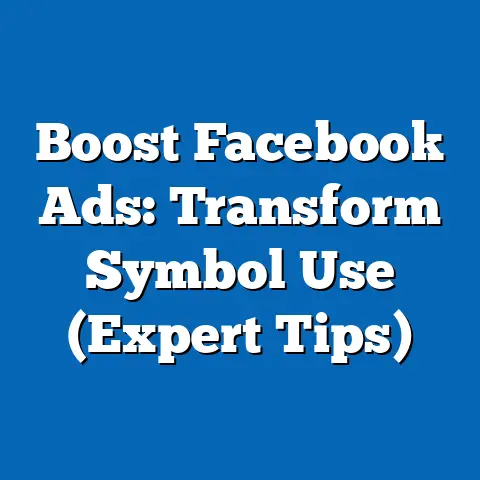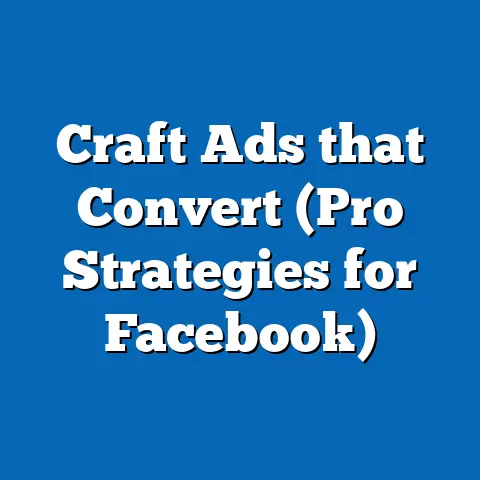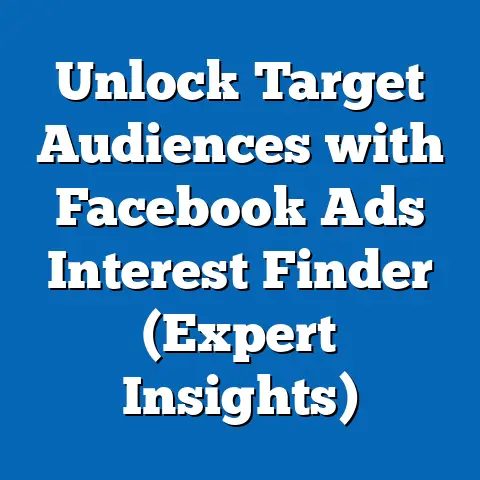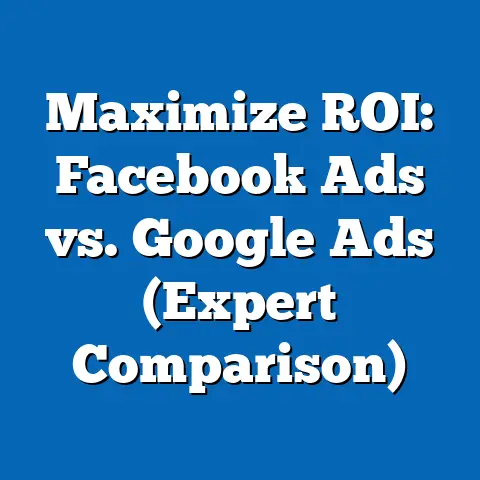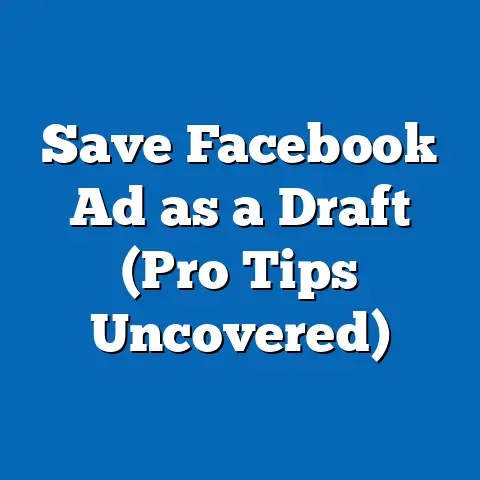Master Facebook & Instagram Ad Specs (Essential Guide)
In the ever-evolving landscape of digital marketing, social media advertising remains a cornerstone for businesses aiming to connect with vast, diverse audiences. Among the leading platforms, Facebook and Instagram stand out as powerhouses, offering unparalleled reach and targeting capabilities. With over 2.9 billion monthly active users on Facebook and 2 billion on Instagram as of 2023 (Statista, 2023), these platforms collectively dominate the social media advertising space, making them essential tools for marketers worldwide.
Section 1: Trends and Statistics in Facebook & Instagram Advertising
1.1 The Dominance of Social Media Advertising
Social media advertising has seen explosive growth over the past decade, with global ad spending projected to reach $219.8 billion by 2024 (eMarketer, 2023). Facebook and Instagram, both under Meta’s umbrella, account for a significant share of this market, with Meta’s ad revenue alone reaching $114.9 billion in 2022 (Meta Annual Report, 2022). This represents a 6.1% year-over-year increase, despite economic uncertainties and privacy regulation challenges like Apple’s iOS tracking changes.
The platforms’ ability to adapt to shifting consumer behaviors and technological advancements has kept them at the forefront. For instance, short-form video content, driven by Instagram Reels and Facebook Stories, has surged in popularity, with 60% of marketers planning to increase video ad budgets in 2023 (Hootsuite Social Media Trends Report, 2023). This trend reflects a broader shift toward dynamic, engaging formats that capture user attention in seconds.
1.2 Demographic Insights: Who’s Using These Platforms?
Understanding the demographic makeup of Facebook and Instagram users is crucial for tailoring ad campaigns. As of 2023, Facebook’s largest user base falls in the 25-34 age group, accounting for 29.9% of its global audience (DataReportal, 2023). However, its user base spans a wide range of ages, with 18.5% aged 18-24 and 21.6% aged 35-44, making it a versatile platform for reaching both younger and older demographics.
Instagram, on the other hand, skews younger, with 31.5% of users aged 18-24 and 30.3% aged 25-34 (DataReportal, 2023). This makes it a go-to platform for brands targeting Gen Z and Millennials, who prioritize visual storytelling and influencer-driven content. Gender distribution is fairly balanced on both platforms, with Facebook at 56.3% male and 43.7% female, and Instagram at 51.8% male and 48.2% female (Statista, 2023).
Geographically, both platforms have a strong presence in emerging markets like India, which is Facebook’s largest market with over 314 million users, and the United States, where Instagram boasts 143 million users (DataReportal, 2023). These regional differences highlight the importance of localized ad strategies to resonate with cultural and linguistic nuances.
1.3 Historical Trends vs. Current Data
Historically, Facebook ads were primarily text- and image-based, with a focus on desktop users. By 2015, mobile ad revenue surpassed desktop for the first time, accounting for 76% of Meta’s total ad revenue (Meta Quarterly Reports, 2015). Fast forward to 2023, mobile ads now constitute over 94% of revenue, reflecting the near-universal shift to smartphones (Meta Q2 2023 Earnings Report).
Instagram, launched in 2010, initially lagged behind Facebook in ad adoption but saw a meteoric rise after its acquisition by Meta in 2012. By 2020, Instagram contributed 26% of Meta’s total ad revenue, a figure that grew to 30% by 2022 as brands flocked to its visually driven platform (eMarketer, 2022). The rise of Stories and Reels has further accelerated this growth, with 70% of users watching Stories daily (Instagram Business Blog, 2023).
1.4 Key Engagement Metrics and Patterns
Engagement remains a critical metric for ad success on both platforms. On Instagram, the average engagement rate for business accounts is 0.83%, with carousel posts often outperforming single images at 1.01% (Later, 2023). Facebook, while generally seeing lower engagement rates at 0.07% for business pages, excels in driving clicks, with an average click-through rate (CTR) of 0.9% across industries (WordStream, 2023).
Demographic differences also influence engagement. Younger users (18-24) on Instagram are more likely to interact with Stories and Reels, while older Facebook users (35+) tend to engage with newsfeed posts and group content. These patterns underscore the need for format-specific strategies based on target audience behavior.
Section 2: Why Ad Specs Matter
2.1 The Role of Specifications in Campaign Success
Ad specifications—guidelines for dimensions, file sizes, and formats—are the backbone of effective social media campaigns. Incorrect specs can lead to distorted visuals, rejected ads, or poor user experiences, ultimately wasting budget and reducing ROI. Meta reports that ads adhering to recommended specs see up to 30% higher engagement rates compared to non-compliant ones (Meta for Business, 2023).
With the variety of ad placements available—such as News Feed, Stories, Reels, and Marketplace—each format demands specific dimensions and creative considerations. Mastering these specs ensures that your content looks professional and performs optimally across devices.
2.2 Evolving Standards in a Mobile-First World
As mobile usage dominates, Meta has continually updated its ad specs to prioritize vertical and square formats over traditional horizontal ones. For example, vertical videos (9:16) in Stories and Reels achieve 20% higher completion rates than horizontal videos on mobile devices (Meta Creative Shop, 2022). This shift reflects how users naturally hold their phones and consume content on the go.
Additionally, file size limits and load times are critical, especially in regions with slower internet speeds. Keeping videos under 4GB and images under 30MB ensures faster delivery without sacrificing quality, a factor that can impact ad reach by up to 15% (Meta Ads Manager Guidelines, 2023).
Section 3: Facebook Ad Specifications (2023)
3.1 Overview of Facebook Ad Placements
Facebook offers a range of ad placements, each with unique specs tailored to its environment. These include News Feed, Stories, Marketplace, In-Stream Video, and Right Column ads. Below is a detailed breakdown of key formats based on Meta’s official guidelines (Meta Ads Manager, 2023).
3.2 Image Ads
- Recommended Dimensions: 1200 x 628 pixels (1.91:1 aspect ratio) for News Feed; 1080 x 1080 pixels (1:1) for square formats.
- File Size: Up to 30MB.
- Text Limit: Primary text (125 characters), headline (27 characters), description (27 characters).
- Key Insight: Images with minimal text (less than 20% of the image area) perform better due to historical restrictions on text-heavy visuals, even though Meta relaxed these rules in 2021.
3.3 Video Ads
- Recommended Dimensions: 1080 x 1080 pixels (1:1) or 1280 x 720 pixels (16:9) for News Feed; 1080 x 1920 pixels (9:16) for Stories.
- Length: 1 second to 241 minutes (shorter videos, under 15 seconds, recommended for higher engagement).
- File Size: Up to 4GB.
- Key Insight: Videos with captions see 12% higher viewership, as 85% of users watch with sound off (Meta Business Insights, 2022).
3.4 Carousel Ads
- Recommended Dimensions: 1080 x 1080 pixels (1:1) per card.
- Number of Cards: 2-10 images or videos.
- File Size: 30MB per image, 4GB per video.
- Key Insight: Carousel ads drive 10-30% more clicks than single-image ads, ideal for showcasing multiple products (WordStream, 2023).
3.5 Stories Ads
- Recommended Dimensions: 1080 x 1920 pixels (9:16).
- Length: Up to 120 seconds for videos; 5 seconds for images.
- Key Insight: Stories ads have a 35% higher CTR compared to News Feed ads for mobile users (Meta for Business, 2023).
(Note: For a visual representation, imagine a table here summarizing dimensions, file sizes, and aspect ratios for each ad type, ensuring quick reference for readers.)
Section 4: Instagram Ad Specifications (2023)
4.1 Overview of Instagram Ad Placements
Instagram’s ad placements include Feed, Stories, Reels, Explore, and IGTV (now integrated into Reels). Given its visual-first nature, specs prioritize high-quality imagery and vertical formats. Below are the key specs from Meta’s 2023 guidelines.
4.2 Image Ads
- Recommended Dimensions: 1080 x 1080 pixels (1:1) for square; 1080 x 1350 pixels (4:5) for vertical.
- File Size: Up to 30MB.
- Text Limit: Primary text (125 characters); minimal text on image recommended.
- Key Insight: Vertical images (4:5) occupy more screen space, leading to 15% higher engagement on mobile (Instagram Business Blog, 2023).
4.3 Video Ads
- Recommended Dimensions: 1080 x 1920 pixels (9:16) for Stories and Reels; 1080 x 1080 pixels (1:1) for Feed.
- Length: 1-60 seconds for Feed; up to 60 seconds for Reels.
- File Size: Up to 4GB.
- Key Insight: Reels ads, introduced in 2021, have a 22% higher interaction rate than standard video ads (Meta Creative Insights, 2023).
4.4 Stories Ads
- Recommended Dimensions: 1080 x 1920 pixels (9:16).
- Length: Up to 60 seconds for videos; 5 seconds for images.
- Key Insight: 62% of users say they’ve become more interested in a brand after seeing it in Stories (Instagram Business, 2023).
4.5 Carousel Ads
- Recommended Dimensions: 1080 x 1080 pixels (1:1) or 1080 x 1350 pixels (4:5).
- Number of Cards: 2-10.
- Key Insight: Carousel ads on Instagram see 1.5x higher swipe-through rates compared to single posts (Later, 2023).
(Note: Visualize a comparison chart here contrasting Instagram and Facebook specs side by side to highlight similarities and differences for dual-platform campaigns.)
Section 5: Best Practices for Optimizing Ads
5.1 Creative Tips for Higher Engagement
- Use High-Quality Visuals: Blurry or low-resolution images can reduce credibility; aim for the highest recommended dimensions.
- Prioritize Mobile-First Design: With 94% of ad impressions on mobile, vertical formats (9:16 or 4:5) are non-negotiable for Stories and Reels.
- Keep Text Concise: Ads with shorter headlines (under 25 characters) see 13% higher CTRs (WordStream, 2023).
5.2 Targeting and Testing Strategies
- Leverage Audience Insights: Use Meta’s Audience Network to target based on demographics, interests, and behaviors. For example, targeting 18-24-year-olds on Instagram with Reels ads yields 25% higher engagement (Meta Ads Manager, 2023).
- A/B Testing: Test multiple ad formats and visuals to identify top performers. Brands report a 20% increase in ROI after consistent split testing (Hootsuite, 2023).
5.3 Compliance with Policies
- Avoid Prohibited Content: Meta strictly prohibits ads promoting tobacco, weapons, or misleading claims. Non-compliance can lead to account suspension.
- Respect Text Limits: While text restrictions have eased, ads with excessive text still risk lower delivery rates.
Section 6: Broader Implications and Future Trends
6.1 The Rise of AI and Automation
Meta’s investment in AI-driven ad tools, like Advantage+ campaigns, is reshaping how marketers approach specs and targeting. These tools automatically optimize creative elements and placements, with early adopters reporting a 17% reduction in cost per acquisition (Meta for Business, 2023). As AI evolves, expect even tighter integration of ad specs with automated design tools.
6.2 Privacy and Data Challenges
With increasing scrutiny on data privacy—such as the EU’s GDPR and Apple’s App Tracking Transparency—marketers must adapt to limited tracking capabilities. Meta estimates a $10 billion revenue loss in 2022 due to iOS changes (Meta Annual Report, 2022). This pushes brands to focus on first-party data and creative quality over hyper-targeted ads.
6.3 The Shift to Immersive Formats
Augmented reality (AR) ads and interactive formats are gaining traction, especially on Instagram, where 50% of users have interacted with AR filters (Instagram Business Blog, 2023). Future ad specs may evolve to support 3D elements and gamified experiences, reflecting user demand for immersion.
Conclusion
Mastering Facebook and Instagram ad specs is not just about meeting technical requirements—it’s about aligning creative strategy with audience behavior and platform trends. With billions of users and billions in ad spend, these platforms offer immense potential for brands willing to invest in precision and adaptability. From mobile-first designs to demographic-specific targeting, the data shows that small adjustments in format and approach can yield significant gains in engagement and ROI.
As digital advertising continues to evolve, staying ahead of trends like AI optimization, privacy shifts, and immersive formats will be key. By grounding campaigns in the latest specs and insights, marketers can navigate this dynamic landscape with confidence, ensuring their message resonates with the right audience at the right time.

